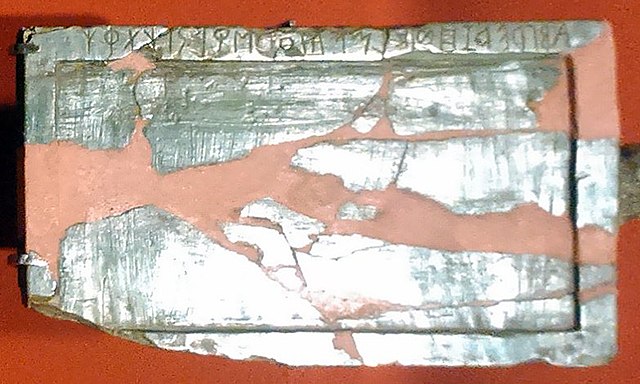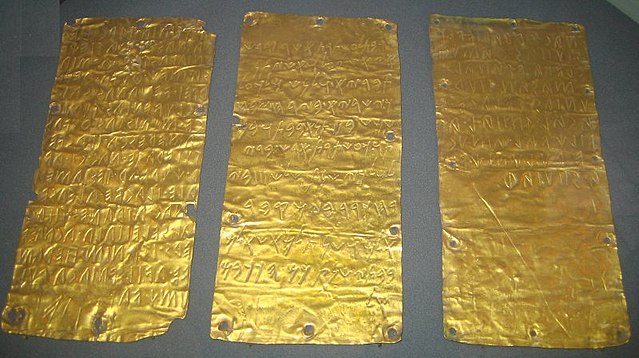The Etruscan alphabet used by the Etruscans, an ancient civilization of central and northern Italy, to write their language, from about 700 BC to sometime around 100 AD.
The Marsiliana Tablet, with an archaic form of the Etruscan alphabet inscribed on the frame
Small Etruscan bottle from 630 to 620 BCE with an early form of the alphabet
Etruscan grave marker from the necropolis Crocifisso del Tufo with an inscription in the Etruscan alphabet
Bowl from Roselle [ru] depicts the south variant of Etruscan alphabet
Etruscan was the language of the Etruscan civilization in the ancient region of Etruria, in Etruria Padana and Etruria Campana in what is now Italy. Etruscan influenced Latin but was eventually completely superseded by it. The Etruscans left around 13,000 inscriptions that have been found so far, only a small minority of which are of significant length; some bilingual inscriptions with texts also in Latin, Greek, or Phoenician; and a few dozen purported loanwords. Attested from 700 BC to AD 50, the relation of Etruscan to other languages has been a source of long-running speculation and study, with it mostly being referred to as one of the Tyrsenian languages, at times as an isolate and a number of other less well-known theories.
The Cippus Perusinus, a stone tablet bearing 46 lines of incised Etruscan text, one of the longest extant Etruscan inscriptions. 3rd or 2nd century BC.
The Orator, ca. 100 BC, an Etrusco-Roman bronze sculpture depicting Aule Metele (Latin: Aulus Metellus), an Etruscan man of Roman senatorial rank, engaging in rhetoric. The statue features an inscription in the Etruscan alphabet
The Pyrgi Tablets, laminated sheets of gold with a treatise both in Etruscan and the Phoenician language, in the Etruscan Museum in Rome
Tumulus on a street at Banditaccia, the main necropolis of Caere




![Bowl from Roselle [ru] depicts the south variant of Etruscan alphabet](https://upload.wikimedia.org/wikipedia/commons/thumb/7/72/8669_-_Museo_archeologico%2C_Grosseto_-_Bucchero_con_alfabeto_etrusco%2C_sec._VI_a.C.._Foto_Giovanni_Dall%27Orto%2C_1_novembre_2015.jpg/640px-8669_-_Museo_archeologico%2C_Grosseto_-_Bucchero_con_alfabeto_etrusco%2C_sec._VI_a.C.._Foto_Giovanni_Dall%27Orto%2C_1_novembre_2015.jpg)



